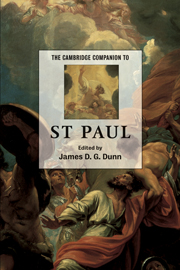Book contents
- Frontmatter
- Introduction
- Part I Paul’s life and work
- Part II Paul’s letters
- 3 1 and 2 Thessalonians
- 4 Galatians
- 5 1 and 2 Corinthians
- 6 Romans
- 7 Philippians
- 8 Colossians and Philemon
- 9 Ephesians
- 10 The Pastoral Epistles
- Part III Paul’s theology
- Part IV St Paul
- Select bibliography
- Index of References
- General Index
10 - The Pastoral Epistles
from Part II - Paul’s letters
Published online by Cambridge University Press: 28 May 2006
- Frontmatter
- Introduction
- Part I Paul’s life and work
- Part II Paul’s letters
- 3 1 and 2 Thessalonians
- 4 Galatians
- 5 1 and 2 Corinthians
- 6 Romans
- 7 Philippians
- 8 Colossians and Philemon
- 9 Ephesians
- 10 The Pastoral Epistles
- Part III Paul’s theology
- Part IV St Paul
- Select bibliography
- Index of References
- General Index
Summary
The term 'Pastoral Epistles' applies to a group of three letters within the New Testament, namely, 1 Timothy, 2 Timothy, and Titus. Already in the thirteenth century Thomas Aquinas (1225-74) referred to 1 Timothy as 'a pastoral rule, which the apostle [Paul] committed to Timothy'. The designation of all three letters as the 'Pastoral Epistles', however, came much later. That is usually attributed to the German scholar Paul Anton (1661-1730), who used the term collectively in lectures and writings in the eighteenth century. The term is descriptive of the aim and contents of the three letters. Among other things, they provide instructions for pastoral oversight of congregations, and they speak of the qualities and duties of church leaders.
THE PASTORALS IN THE EARLY CHURCH
Each of the Pastorals begins by identifying Paul the apostle as its author. Each one goes on to represent itself as a communication from Paul to either Timothy or Titus, persons entrusted with obligations to teach and provide leadership within churches committed to their care. The letters provide further instructions in carrying out those obligations in the present and on into the future.
- Type
- Chapter
- Information
- The Cambridge Companion to St Paul , pp. 141 - 156Publisher: Cambridge University PressPrint publication year: 2003
- 2
- Cited by



